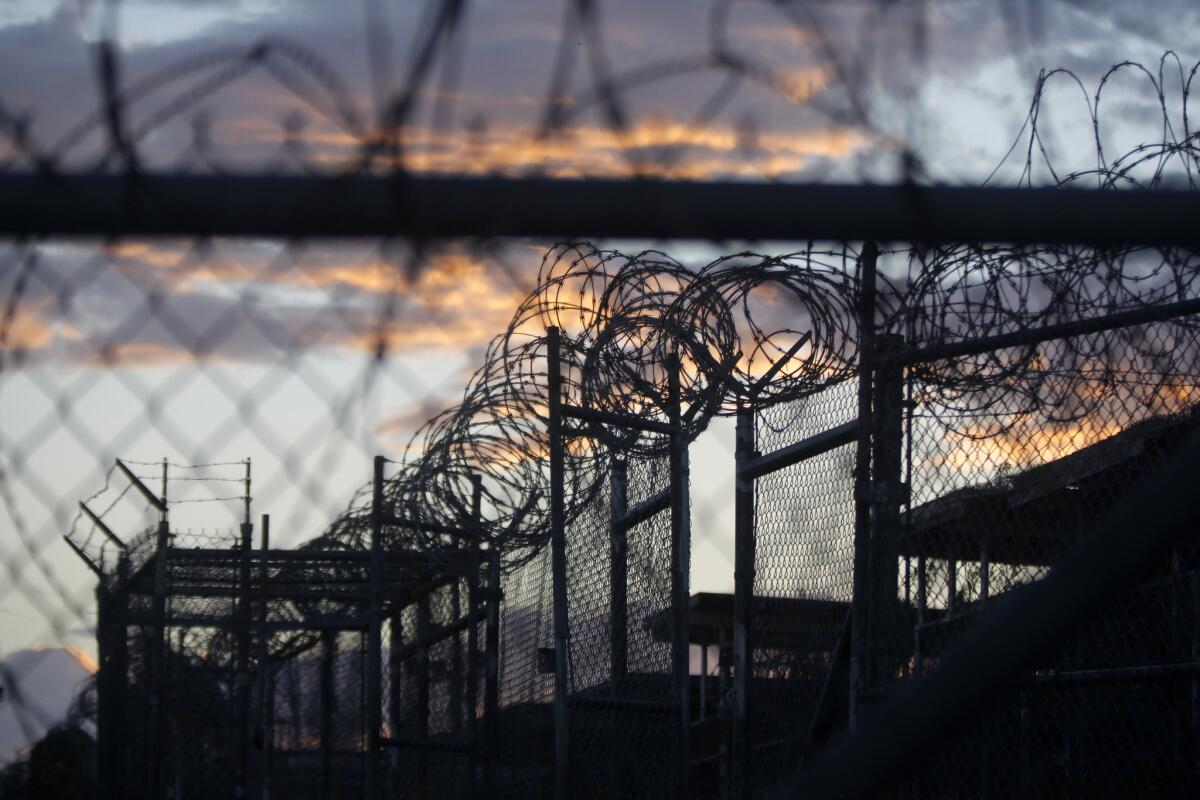15 Guantanamo detainees, held without charge, are released to the United Arab Emirates

Reporting from PORT-AU-PRINCE, Haiti â Fifteen prisoners at the Guantanamo Bay detention center were sent to the United Arab Emirates in the single largest release of detainees during the Obama administration, the Pentagon announced Monday.
The transfer of 12 Yemeni nationals and three Afghans to the UAE comes amid a renewed push to whittle down the number of detainees held at the U.S. prison in Cuba that President Obama aims to close.
The Pentagon says 61 detainees now remain at Guantanamo, which was opened in January 2002 to hold foreign fighters suspected of links to the Taliban or the Al Qaeda terrorist organization. During the Bush administration, 532 prisoners were released from Guantanamo, often in large groups to Afghanistan and Saudi Arabia.
The latest batch of released prisoners had been held without charge at Guantanamo, some for over 14 years. They were cleared for release by the Periodic Review Board, comprising representatives from six U.S. government agencies.
The UAE successfully resettled five detainees transferred there last year, according to the Pentagon. In July 2008, the seven-emirate nation also repatriated UAE citizen and Guantanamo prisoner Abdulah Alhamiri at the same time that Afghanistan and Qatar each accepted one prisoner.
In the United Arab Emirates, the state-run WAM news agency had no reports on the Guantanamo transfers on Tuesday and UAE officials declined to immediately comment on the Pentagon announcement.
The United Arab Emirates is a major regional military ally for the U.S., as it hosts American military personnel targeting the Islamic State group with airstrikes in Iraq and Syria. Dubaiâs Jebel Ali port is the most frequently visited by ships of the U.S. Navy outside of America.
Lee Wolosky, the State Departmentâs special envoy for Guantanamoâs closure, said the U.S. was grateful to the United Arab Emirates for accepting the latest group of 15 men and helping pave the way for the detention centerâs closure.
âThe continued operation of the detention facility weakens our national security by draining resources, damaging our relationships with key allies and partners, and emboldening violent extremists,â Wolosky said.
Itâs unclear what has happened to prisoners the UAE previously took in, though itâs widely believed they undergo some sort of government-monitored rehabilitation. Of those already taken in, there have been no complaints of maltreatment, said Clive Stafford Smith, the director of the British-based advocacy group Reprieve, which represented one of the Yemenis released.
âFrom what weâve learned, theyâve been treated pretty well,â he told the Associated Press. âTheyâve been banned from traveling and any meaningful communication. ... Theyâve actually been OK. Arabic is the main language and itâs pretty close to home.â
Obama has been seeking to close the detention center amid opposition from Congress, which has prohibited transferring detainees to the U.S. for any reason. The administration has been working with other countries to resettle detainees who have been cleared for transfer.
Naureen Shah, Amnesty International USAâs director of national security and human rights, said the transfers announced Monday are a âpowerful sign that President Obama is serious about closing Guantanamo before he leaves office.â
U.S. Rep. Ed Royce, a Republican from California who is chairman of the House Foreign Affairs Committee, criticized the Obama administration for recent releases, portraying the freed detainees as âhardened terrorists.â
The Office of the Director of National Intelligence says 5% of Guantanamo prisoners released since Obama took office have re-engaged in militant activities and an additional 8% are suspected of doing so. That compares with 21% confirmed and 14% suspected during the Bush administration.
According to Amnesty, one of the Afghans released to the UAE alleged that he was âtortured and subjected to other cruel treatmentâ while in U.S. military custody. The man, identified only as Obaidullah, was captured by U.S. special forces in July 2002 and allegedly admitted to acquiring and planting anti-tank mines to target U.S. and other coalition forces in eastern Afghanistan.
In clearing him for transfer, the review board said he hasnât expressed any anti-U.S. sentiment or intent to re-engage in militant activities. However, a Pentagon profile from last year also said he provided little information and they had little âinsight into his current mindset.â
One of the Yemeni men sent to the UAE was identified as Zahir Umar Hamis bin Hamdun, who the Pentagon alleged traveled to Afghanistan in 1999 and after training at a camp acted as a weapons and explosives trainer.
A Pentagon profile from September 2015 said he expressed dislike of the U.S., which they identified as âan emotion that probably is motivated more by frustration over his continuing detention than by a commitment to global jihad.â
Returning Guantanamo prisoners to Yemen would be difficult as a two-year civil war is raging in the Arab worldâs most impoverished country. The conflict there pits an internationally recognized government, backed by a coalition led by Saudi Arabia, a Sunni powerhouse, against Shiite rebels known as Houthis and their allies. The UAE is a part of that Saudi-led coalition.
There was also no immediate reaction in Afghanistan on the transfer of the three Afghans from Guantanamo to the UAE.
ALSO
Third French city bans âburkiniâ after brawl at beach leaves 5 injured
Brazilâs current and former presidents face trials. And the interim president is in hot water too
More to Read
Sign up for Essential California
The most important California stories and recommendations in your inbox every morning.
You may occasionally receive promotional content from the Los Angeles Times.










